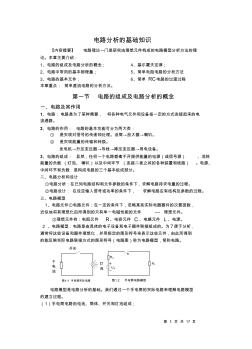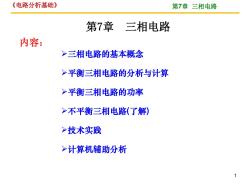chapter 1 circuit variables and circuit elements .
1.1 circuit analysis: an overview
1.2 voltage, current, and the basic circuit elements
1.3 the ideal basic circuit element
1.4 power and energy
1.5 voltage and current sources
1.6 electrical resistance (ohmos law)
1.7 kirchhoffos laws
1.8 analysis of a circuit containing dependent sources
chapter 2 some circuit simplification techniques
2.1 source transformations
2.2 superposition
chapter 3 techniques of circuit analysis
3.1 terminology
3.2 introduction to the node-voltage method
3.3 the node-voltage method and dependent sources
3.4 the node-voltage method: some special cases
3.5 introduction to the mesh-current method
3.6 the mesh-current method and dependent sources
3.7 the mesh-current method: some special cases
.3.8 the node-voltage method versus the mesh-current method
3.9 thvenin and norton equivalents
3.10 more on deriving a thvenin equivalent
3.11 maximum power transfer
chapter 4 the operational amplifier ..
4.1 operational amplifier terminals
4.2 terminal voltages and currents
4.3 the inverting-amplifier circuit
4.4 the summing-amplifier circuit
4.5 the noninverting-amplifier circuit
4.6 the difference-amplifier circuit
4.7 the comparator
chapter 5 the natural and step response of rl and rc circuits
5.1 the inductor
5.2 the capacitor
5.3 series-parallel combinations of inductance and capacitance
5.4 natural response of rl and rc circuits
5.5 step response of rl and rc circuits
5.6 the integrating amplifier
chapter 6 natural and step responses of rlc circuits
6.1 introduction to the natural response of a parallel rlc circuit
6.2 the forms of the natural response of a parallel rlc circuit
6.3 the step response of a parallel rlc circuit
6.4 the natural and step response of a series rlc circuit
chapter 7 sinusoidal steady-state analysis
7.1 the sinusoidal source
7.2 the sinusoidal response
7.3 the phasor
7.4 the passive circuit elements in the frequency domain
7.5 kirchhoffos laws in the frequency domain
7.6 circuit simplifications
7.7 the node-voltage method
7.8 the mesh-current method
7.9 instantaneous, average, and reactive power
7.10 the rms value and power calculations
7.11 complex power and power calculations
chapter 8 balanced three-phase circuits
8.1 balanced three-phase voltages
8.2 three-phase voltage sources
8.3 analysis of the wye-wye circuit
8.4 analysis of the wye-delta circuit
8.5 power calculations in balanced three-phase circuits
8.6 measuring average power in three-phase circuits
chapter 9 introduction to frequency selective circuits
9.1 some preliminaries
9.2 low-pass filters
9.3 high-pass filters
9.4 bandpass filters
9.5 bandreject filters

 电路分析基础知识
电路分析基础知识

 电路分析基础三相电路..
电路分析基础三相电路..